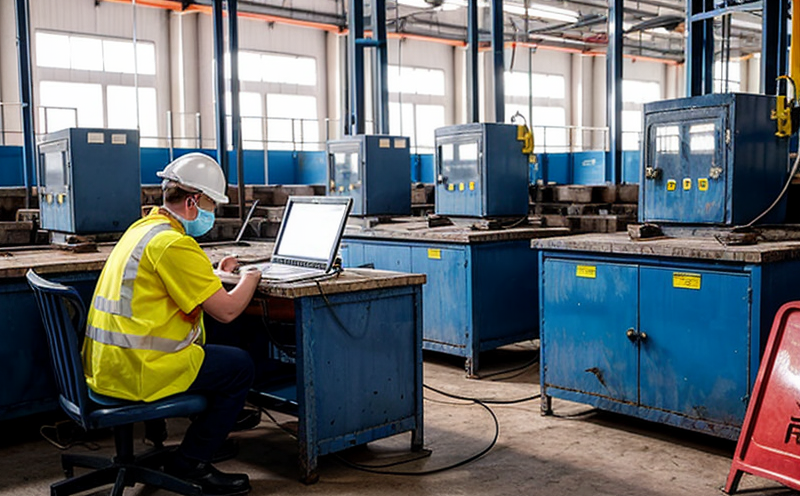ASTM E119 Fire Resistance Testing of Structural Elements
The ASTM E119 standard is one of the most widely recognized and respected methods for evaluating the fire resistance performance of structural elements in industrial manufacturing facilities. This service ensures that critical components used in factory environments meet stringent safety requirements, thereby protecting workers from potential hazards during a fire event.
Fire resistance testing under ASTM E119 involves subjecting structural elements to controlled exposure to high-temperature and flame conditions for specified durations. The goal is to assess the ability of these materials to maintain their integrity, stability, and insulation properties over time without compromising safety or functionality. This process helps manufacturers and quality managers ensure that their products meet local and international standards.
The testing procedure typically starts with precise preparation of specimens according to ASTM E119 requirements. Specimens are then placed into a furnace where they undergo controlled heating until reaching the specified temperature range. During this time, various parameters such as heat transfer rate, thermal conductivity, and temperature distribution within the specimen are continuously monitored.
After exposure, specimens are carefully inspected for any signs of damage or deformation that might indicate poor fire resistance performance. Key aspects examined include load-bearing capacity, structural stability, and insulation effectiveness. Compliance with ASTM E119 criteria ensures that tested materials can withstand extreme temperatures without failing catastrophically during a real-fire scenario.
Compliance with this standard is crucial for industrial facilities because it guarantees the safety of workers while enhancing overall operational reliability. By adhering to ASTM E119, manufacturers demonstrate their commitment to producing high-quality products that meet rigorous performance expectations. This not only builds customer trust but also helps avoid costly recalls or accidents down the line.
For quality managers and compliance officers looking to ensure their facilities comply with relevant regulations, ASTM E119 offers a robust framework for evaluating structural elements' fire resistance capabilities. Proper implementation of this standard can lead to enhanced safety measures within factories, contributing significantly towards creating safer working environments.
Scope and Methodology
The scope of ASTM E119 encompasses the evaluation of fire resistance performance for various types of structural elements commonly found in industrial facilities. These include columns, beams, trusses, and other load-bearing components used to support buildings or machinery.
- Columns: Tested for their ability to maintain stability under extreme heat without collapsing.
- Bolts & Connectors: Assessed for retention strength after exposure to fire conditions.
- Trusses: Evaluated based on their capacity to retain structural integrity during prolonged high-temperature exposures.
The methodology involves placing specimens into a furnace where they are exposed to controlled levels of heat and flame. The duration and intensity of these exposures depend on the specific material being tested and its intended application within an industrial setting.
| Parameter | Description |
|---|---|
| Temperature Range | Between 500°C and 1,370°C depending on the test specimen. |
| Duration of Exposure | From minutes to hours based on the specific material properties being evaluated. |
| Load Application | Simulates real-world conditions by applying loads during testing. |
The testing process also includes monitoring key performance indicators such as weight loss, structural deformation, and insulation effectiveness. Specimens that pass the ASTM E119 test demonstrate their ability to retain essential functions even after prolonged exposure to intense heat and flames.
International Acceptance and Recognition
The ASTM E119 standard enjoys widespread acceptance across numerous industries, particularly in regions where strict regulatory requirements govern industrial safety practices. Its international recognition stems from its rigorous approach to evaluating structural elements' fire resistance capabilities, making it a preferred choice for manufacturers aiming to comply with global standards.
Many countries have adopted ASTM E119 as part of their national codes and regulations governing fire safety in industrial settings. Organizations like the International Organization for Standardization (ISO) often reference ASTM E119 when developing international guidelines related to structural integrity during fires. This cross-recognizability ensures consistency across different markets, facilitating smoother international trade and collaboration.
For manufacturers operating globally, compliance with ASTM E119 provides a competitive advantage by demonstrating their commitment to high-quality standards that meet or exceed local requirements in various jurisdictions. It also simplifies the process of navigating complex regulatory landscapes when expanding into new markets.
In summary, ASTM E119's broad acceptance and international recognition underscore its importance as an essential tool for ensuring fire safety in industrial manufacturing facilities worldwide.
Use Cases and Application Examples
- Steel Fabrication: Ensuring structural integrity during high-temperature exposure for steel used in factory construction.
- Bolting Systems: Evaluating the retention strength of bolts under extreme heat conditions to prevent failure during a fire event.
- Metal Trusses: Assessing truss members' capability to retain their shape and function after prolonged exposure to intense flames.
In these examples, ASTM E119 plays a critical role in confirming that structural components used in industrial facilities meet stringent fire resistance requirements. By adhering to this standard, manufacturers can ensure the safety of workers while enhancing operational reliability within factories.





